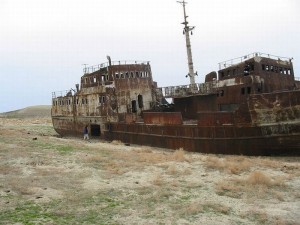- The Aral Sea basin contains over 14,752 glaciers with a total area of some 1,043 km2. The ones located in Uzbekistan account for 1.1% of the total glaciated area in Central Asia. Recent assessments indicate that the country’s glaciers and ice reserves are receding. Since 1957 the glaciers have shrunk by almost 20%, losing 104 billion m3 of water.
- The bulk of freshwater resources in Uzbekistan comes from the Syr Darya, a river originating in Tajikistan; the Amu Darya, which flows in from Kyrgyzstan; and, to a lesser extent, the Kashka Darya and Zarafshan rivers.
Available freshwater resources in Uzbekistan are estimated at 67 billion m3 per year. Of this amount, 55.1 billion m3 comes from surface waters and 7.8 billion m3 from groundwater. - Although only 10% of the 444,000 km2 of arable land is irrigated, the irrigation efficiency is low, so this water demand amounts to 92.5% of overall annual water consumption in Uzbekistan.
- With demand for water growing in all sectors, it will be impossible to meet the combined needs in the medium term. Projections based on existing consumption trends indicate there could be a water deficit of up to 14 billion m3 by 2015.
- The main legislation governing water management is the 1993 Law on Water and Water Use. Uzbekistan is in the process of adopting a series of measures intended to improve water supply so as to promote employment and better living standards.
- Inefficient use of water in irrigation, combined with ineffective drainage systems, has flooded large areas of land with a mixture of fresh and polluted return water. Aerial photos taken in 2005 reveal pools of semicontaminated water, covering as much as 800 km2 in all.
The section “Did You Know…?” is taken from the 3rd World Water Development Report “Water in a Changing World“.


